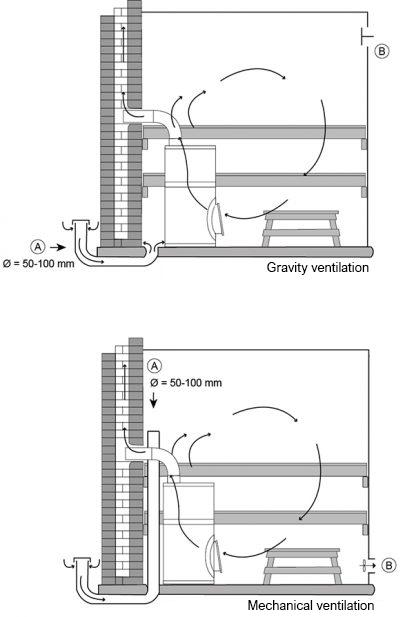Instructions
Installation instructions for IKI Wood-burning stoves and electric heaters
Electric heaters
General
1. Only a licensed electrician is allowed to install the heater.
2. After sauna-bathing, we recommend switching the heater on again for about 10 minutes in order to help dry out the steam room.
3. In standard use, we recommend the use of basic sauna stones (e.g. olivine diabase) no larger than 10 cm in diameter. The stones should be placed into the heater so that there is enough room for air to circulate freely around the stones.
4. In commercial and communal use, IKI-Kiuas recommends using KERKES ceramic interspace sauna stones around the heating elements. The specially designed Kerkes stones support and protect the heating elements from premature disintegration. NOTE that soapstone and natural stones may only be used on the surface. Make sure to lay the stones carefully so that the heating elements DO NOT touch one another, or the outer casing
As a rule, a heater is selected based on the volumetric dimensions of the sauna room. The functioning of heaters manufactured by IKI-Kiuas Oy is based on the heat retention capacity of the large amount of stones. This means that the heater’s power capacity requirement is not greatly affected by stone and glass surfaces in the sauna room. However, if there are a lot of stone or glass surfaces in the sauna, it is advisable to pick the more powerful model if the volumetric dimensions of the room are close to the limits.
Log walls heat up slowly, so a more efficient heater should be selected in this case as well. When selecting the appropriate heater, it is advisable to ask the reseller or IKI-Kiuas technical support for advice. Bear in mind also that the walls and the ceiling of the sauna room must also be well insulated. All surfaces that store heat must be thermally insulated. 1 square meter of uninsulated surface in the ceiling or on the walls increases the heater’s power requirement. As a rule of thumb: add 1.2 to 1.5 cubic meters to the room volume per every square meter of uninsulated surface. In saunas that have glass surfaces and walls, it is especially important to carefully calculate the heater’s power requirement in relation to the volumetric dimensions of the room.
The height of the sauna room itself should be relatively low. The higher the room, the more powerful the heater needs to be, as additional height increases the room’s volumetric dimensions. As warm air rises up, the recommended height between the seats and the ceiling is a maximum of 1200 mm.
If the heater is not powerful enough, the temperature in the steam room will remain too low. In which case, sauna-goers often attempt to raise temperature by throwing more water on to the heater. This in turn quickly cools down the stones. And finally, there is no steam to be got out of a tepid heater
The stones should be placed carefully. The distance between the resistors and the mesh frame should be completely covered by stones, all the way around and to the top of the heater. However, the stones must not be stacked too tightly; there need to be slight gaps between the stones to ensure unobstructed air circulation.
In privately used saunas, we recommend using olivine, olivine diabase or peridot stones. The stones should be less than 10 cm in diameter, making them easy to stack between the heater’s frame and the resistors. In normal conditions, the stones should be replaced every 2 to 5 years, depending on the degree of use.
NOTE! When laying the stones, make sure that the resistors ARE NOT in contact with one another or the outer casing of the heater.
According to building regulations the minimum height for a sauna room is 1900 mm. Usually anything between 2000 to 2300 mm is good. The room height affects energy consumption and increases heating time. Thus, room height also affects the heater’s power requirements. The required power of the heater is calculated based on the cubic volume of the sauna room. The recommended height between the upper bench and the ceiling is a maximum of 1200 mm.
Proper thermal insulation of the walls and the ceiling structures have a significant role in retaining a uniform temperature inside the sauna room. The better the insulation, the lower the energy required for heating. Therefore, special attention should be paid to the U-value of the materials used for thermal insulation. Thin materials often have low U-values, despite “increasing” the space inside the room.
All heat-storing surfaces must be thermally insulated in the same way as the walls. Uninsulated surface in the ceiling or on the walls increases the heater’s power requirement by 1.2. With regards to uninsulated surfaces, it is always advisable to read the manufacturers’ operating instructions. Often a good rule of thumb is that 1 square of uninsulated surface adds 1.2 to 1.5 cubic meters to the room’s volumetric dimensions. If there are glass surfaces and walls in the sauna room, it is important to carefully calculate the power requirements for the heater in relation to the volumetric dimensions of the room.
Installation instructions
There might be downtime with UKU control unit because of a server update. If there is a text ”loading update” in control panels display, the problem is fixed by turning the fuses of the sauna down and back up. The control unit then connects to the right server.
- Pillar-IKI 4,5-9 kW with mounted control unit (PDF)
- Pillar-IKI 4,5-12 kW separate control unit (PDF)
- Pillar-IKI 4,5-10 kW Finlandia control unit (PDF)
- Pillar-IKI 15-30 kW with separate control unit (PDF)
- Pillar-IKI 13,8-36 kW with separate control unit (PDF)
- Corner and Wall IKI with mounted control unit (PDF)
- Corner and Wall IKI with separate control unit (PDF)
- Corner and Wall IKI with Finlandia control unit (PDF)
- Monolith electric heaters (PDF)
- Float electric heater 13,8 kW (PDF)
- IKI Pro electric heaters (PDF)
Note: Finlandia control unit is integrated in the heater so the instructions can be found from the heaters installation instructions.
Electric heaters 4,5-10 kW:
- Pillar-, Corner-, Wall-IKI 4,5-6 kW Finlandia (PDF)
- Pillar-, Corner- Wall-IKI 7,5-10 kW Finlandia (PDF)
- Pillar-, Corner- Wall-IKI 4,5-6 kW UKU Glass Wi-Fi (PDF)
- Pillar-, Corner- Wall-IKI 7,5-10 kW UKU Glass Wi-Fi (PDF)
- Pillar-, Corner-, Wall-IKI 4,5-6 kW Wave (PDF)
- Pillar-, Corner-, Wall-IKI 7,5-10 kW Wave (PDF)
- Pillar-, Corner-, Wall-IKI 7,5-10 kW Pro-B2 (PDF)
Electric heaters 12-30 kW:
- Pillar-IKI 12-18 kW UKU Glass Wi-Fi (PDF)
- Pillar-IKI 12 kW Wave 2-phase (PDF)
- Pillar-IKI 15 kW Wave 2-phase (PDF)
- Pillar-IKI 18 kW Wave 2-phase (PDF)
- Pillar-IKI 12-15 kW Wave 1-phase (PDF)
- Pillar-IKI 12 kW Pro-B2 2-phase (PDF)
- Pillar-IKI 15 kW Pro-B2 2-phase (PDF)
- Pillar-IKI 18 kW Pro-B2 2-phase (PDF)
- Pillar-IKI 20 kW Pro-B2 2-phase (PDF)
- Pillar-IKI 24 kW Pro-B2 2-phase (PDF)
- Pillar-IKI 30 kW Pro-B2 2-phase (PDF)
- Pillar-IKI 12-15 kW Pro-B2 1-phase (PDF)
- Pillar-IKI 18-20 kW Pro-B2 1-phase (PDF)
Monolith electric heaters:
- Monolith 6,9 kW UKU Glass Wi-Fi (PDF)
- Monolith 9 kW UKU Glass Wi-Fi (PDF)
- Monolith 18 kW UKU Glass Wi-Fi (PDF)
- Monolith 6,9 kW Wave (PDF)
- Monolith 9 kW Wave (PDF)
- Monolith 13,8 kW Wave 2-phase (PDF)
- Monolith 15,9 kW Wave 2-phase (PDF)
- Monolith 18 kW Wave 2-phase (PDF)
- Monolith 13,8 kW Pro-B2 2-phase (PDF)
- Monolith 15,9 kW Pro-B2 2-phase (PDF)
- Monolith 18 kW Pro-B2 2-phase (PDF)
- Monolith 13,8-15,9 kW Pro-B2 1-phase (PDF)
- Monolith 18 kW Pro-B2 1-phase (PDF)
IKI Pro electric heaters:
- IKI Pro 14 Pro-B2 2-phase (PDF)
- IKI Pro 21 Pro-B2 2-phase (PDF)
- IKI Pro 28 Pro-B2 2-phase (PDF)
- IKI Pro 35 Pro-B2 2-phase (PDF)
IKI Float electric heater:
Wood Burning Stoves
General
1. We recommend that wood-burning sauna stoves are installed primarily to either a) a brick flue b) a ceramic flue, or c) an air-cooled flue (IKI T600 Chimney). The suitability of other types of flues must be ensured case by case by conferring with the manufacturer of the flue.
2. IKI-Kiuas Oy recommends installing a flue damper to adjust the draft in the flue. There is no grate with which to adjust draft. Instead, the stoves are equipped with a so-called “nasal hatch” which can be used to adjust draft.
3. The fireplaces and chimneys in privately used holiday homes should be swept every three years. The fireplaces and chimneys of private dwellings in permanent residential use as well as shared holiday homes that are in regular use throughout the year should be swept every year. The diameter of the outer edge of the flue pipe is 115 mm.
4. Storing flammable materials (e.g. fuels) in the proximity of the fireplace is prohibited.
5. All soot fires (even extinguished ones) must always be reported to the fire authorities.
6. Heat up the sauna for the first time without bathing to burn off any potentially dangerous coatings and oils remnants left on metal and steel surfaces.
7. In normal use, we recommend olivine diabase stones (e.g. by Parhaat Löylyt) no larger than 10 cm in diameter. Lay the stones carefully and leave slight gaps between the stones to ensure unobstructed air circulation.
The stones should be placed carefully. The stones must not be stacked too tightly; there need to be slight gaps between the stones to ensure unobstructed air circulation. We recommend the use of basic sauna stones (e.g. olivine diabase) no larger than 10 cm in diameter.
Choose the correct stove model carefully. Prolonged use of a stove that is not powerful enough may shorten its lifespan. Note that all uninsulated surfaces on the walls and the ceiling (e.g. brick, glass, tile, concrete) increase the need for heating capacity. When calculating the sauna room’s volumetric dimensions, you need to add approximately 1.2m3 for each uninsulated square meter. If the walls are solid log, the volume should be multiplied by 1.5.
As an example:
– A sauna room the size of 10m3 with one brick wall measuring 2 by 2 meters corresponds to 15m3.
– A sauna room the size of 10m3 with solid log walls also corresponds to 15m3.
For more detailed information on sizing, contact the manufacturer directly: tuki@ikikiuas.fi
.


